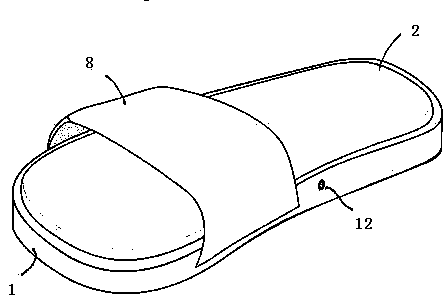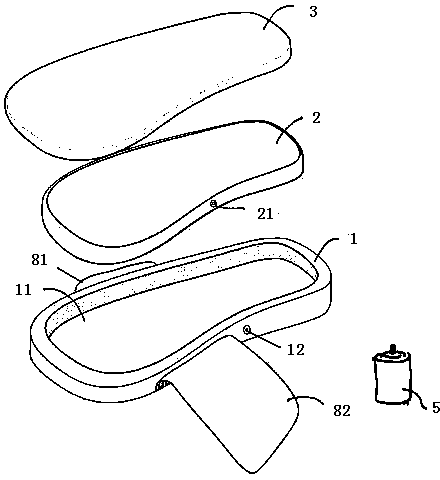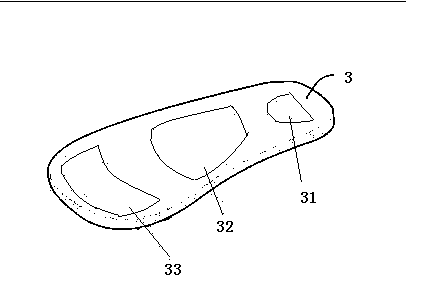Shoe sole used for diabetic patient and slipper made of shoe sole
A technology for diabetics and patients, which is applied in the field of slippers, can solve the problems of not being able to meet the comfort requirements of diabetics, inconvenient to use by different diabetics, and the function is not up to the ideal state, so as to ensure stability and comfort, good flexibility, The effect of good comfort
- Summary
- Abstract
- Description
- Claims
- Application Information
AI Technical Summary
Problems solved by technology
Method used
Image
Examples
Embodiment 1
[0074] The material of the airbag layer 2 is polyurethane modified rubber; the polyurethane modified rubber includes 20 parts by weight of polyol and 8 parts by weight of MDI isocyanate, and also includes 3 parts by weight of cyclopentane, triethylenediamine, surfactant, 0.5 parts by weight of Sulfonate flame retardant and 0.8 parts by weight room temperature vulcanized silicone rubber;
[0075] The polyol is a copolyol of trimethylolpropane and ethylene oxide, the EO content is greater than 60%, and the hydroxyl value is 3-22mgKOH / g; trimethylolpropane is formed by a double metal cyanide complex catalyst.
[0076] The bottom layer 1 material is composed of the following raw materials in parts by weight: 30 parts of butadiene rubber, 20 parts of styrene-butadiene rubber, 10 parts of precipitated hydrated silica, 2 parts of zinc stearate, 1 part of polyethylene glycol, propyl peroxide 6 parts of oxydiisopropenylbenzene, 15 parts of calcium carbonate and 2 parts of dioctyl ester...
Embodiment 2
[0086] The material of the airbag layer 2 is polyurethane modified rubber; the polyurethane modified rubber includes 85 parts by weight of polyol and 30 parts by weight of MDI isocyanate, and also includes 3 parts by weight of cyclopentane, triethylenediamine, surfactant, 0.2 parts by weight of Sulfonate flame retardant and 0.2 parts by weight room temperature vulcanized silicone rubber;
[0087] The polyol is a copolyol of trimethylolpropane and ethylene oxide, the EO content is greater than 60%, and the hydroxyl value is 3-22mgKOH / g; trimethylolpropane is formed by a double metal cyanide complex catalyst.
[0088] The bottom layer 1 material is composed of the following raw materials in parts by weight: 30-38 parts of butadiene rubber, 22 parts of styrene-butadiene rubber, 16 parts of precipitated hydrated silica, 3 parts of zinc stearate, 1.8 parts of polyethylene glycol, propylene glycol 9 parts of diisopropenylbenzene, 10 parts of calcium carbonate and 1 part of dioctyl e...
Embodiment 3
[0098] The material of the airbag layer 2 is polyurethane modified rubber; the polyurethane modified rubber includes 65 parts by weight of polyol and 20 parts by weight of MDI isocyanate, and also includes 5 parts by weight of cyclopentane, triethylenediamine, surfactant, 0.3 parts by weight of Sulfonate flame retardant and 0.4 parts by weight room temperature vulcanized silicone rubber;
[0099] The polyol is a copolyol of trimethylolpropane and ethylene oxide, the EO content is greater than 60%, and the hydroxyl value is 3-22mgKOH / g; trimethylolpropane is formed by a double metal cyanide complex catalyst.
[0100] The bottom layer 1 material is composed of the following raw materials in parts by weight: 30-38 parts of butadiene rubber, 21 parts of styrene-butadiene rubber, 15 parts of precipitated hydrated silica, 2.5 parts of zinc stearate, 1.5 parts of polyethylene glycol, propylene glycol 8 parts of diisopropenylbenzene, 13 parts of calcium carbonate and 1.5 parts of dioc...
PUM
 Login to View More
Login to View More Abstract
Description
Claims
Application Information
 Login to View More
Login to View More - R&D
- Intellectual Property
- Life Sciences
- Materials
- Tech Scout
- Unparalleled Data Quality
- Higher Quality Content
- 60% Fewer Hallucinations
Browse by: Latest US Patents, China's latest patents, Technical Efficacy Thesaurus, Application Domain, Technology Topic, Popular Technical Reports.
© 2025 PatSnap. All rights reserved.Legal|Privacy policy|Modern Slavery Act Transparency Statement|Sitemap|About US| Contact US: help@patsnap.com



